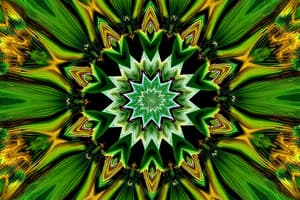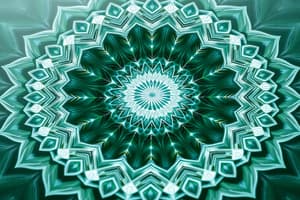Podcast
Questions and Answers
Which of the following best describes mathematics?
Which of the following best describes mathematics?
- The study of historical events
- The study of the Earth's atmosphere
- The study of relationships among numbers, quantities, and shapes (correct)
- The study of living organisms
What is a key characteristic of patterns?
What is a key characteristic of patterns?
- Always complex and difficult to understand
- Never found in nature
- Regular, repeated, or recurring forms (correct)
- Completely random occurrences
Which of the following is an example of symmetry?
Which of the following is an example of symmetry?
- A chaotic and unpredictable system
- A process that never repeats
- A randomly scattered set of points
- An object that can be divided into mirror-image parts (correct)
What is a spiral?
What is a spiral?
Which of the following is an example of a wave?
Which of the following is an example of a wave?
What is the Fibonacci sequence?
What is the Fibonacci sequence?
What is the approximate value of the Golden Ratio?
What is the approximate value of the Golden Ratio?
What is an arithmetic sequence?
What is an arithmetic sequence?
What is a geometric sequence?
What is a geometric sequence?
In a quadratic sequence, what is constant?
In a quadratic sequence, what is constant?
What does a mathematical language provide?
What does a mathematical language provide?
What is a variable?
What is a variable?
What is a mathematical expression?
What is a mathematical expression?
What is a monomial expression?
What is a monomial expression?
What does the symbol ∈ mean?
What does the symbol ∈ mean?
What is an empty set?
What is an empty set?
What are equal sets?
What are equal sets?
What are equivalent sets?
What are equivalent sets?
What is a subset?
What is a subset?
Flashcards
Mathematics
Mathematics
Study of relationships among numbers, quantities, and shapes, including arithmetic, algebra, trigonometry, geometry, statistics, and calculus.
Patterns
Patterns
Regular, repeated, or recurring forms or designs seen in nature and can be modeled mathematically.
Symmetry
Symmetry
When an object can be divided into mirror-image parts.
Spiral
Spiral
Signup and view all the flashcards
Foams
Foams
Signup and view all the flashcards
Tessellation (Tiling)
Tessellation (Tiling)
Signup and view all the flashcards
Fibonacci Sequence
Fibonacci Sequence
Signup and view all the flashcards
Golden Ratio (Φ ≈ 1.618)
Golden Ratio (Φ ≈ 1.618)
Signup and view all the flashcards
Sequence
Sequence
Signup and view all the flashcards
Arithmetic Sequence
Arithmetic Sequence
Signup and view all the flashcards
Geometric Sequence
Geometric Sequence
Signup and view all the flashcards
Quadratic Sequence
Quadratic Sequence
Signup and view all the flashcards
Mathematical Language
Mathematical Language
Signup and view all the flashcards
Variable
Variable
Signup and view all the flashcards
Mathematical Expression
Mathematical Expression
Signup and view all the flashcards
Mathematical Sentence
Mathematical Sentence
Signup and view all the flashcards
Definition of a Set
Definition of a Set
Signup and view all the flashcards
Empty / Null / Void Set
Empty / Null / Void Set
Signup and view all the flashcards
Operations on Functions: Addition
Operations on Functions: Addition
Signup and view all the flashcards
Definition of a Function
Definition of a Function
Signup and view all the flashcards
Study Notes
Mathematics
- It involves studying the relationships between numbers, quantities, and shapes
- Includes fields like arithmetic, algebra, trigonometry, geometry, statistics, and calculus
- Mathematics aids in organizing patterns and regularities observed
- Functions as a science of patterns, helping to recognize and generalize patterns
Patterns in Nature
- Patterns are regular, repeated, or recurring forms seen in nature.
- Can be modeled mathematically
- Examples of patterns include symmetries, spirals, waves, foams, and tessellations
Symmetry
- Symmetry is when an object can be divided into mirror-image parts.
- Types of symmetry include line or bilateral symmetry and rotational symmetry
Spiral
- A spiral is a curve that starts from a central point
- Moves progressively farther away as it revolves around the point
Wave
- A wave involves a moving disturbance of one or more quantities, such as sound, water, or light
Foams
- Foams are materials formed by trapping gas within a liquid or solid
Tessellation (Tiling)
- Involves covering a surface with shapes without leaving gaps or overlaps
History of Pattern Study
- Plato, Pythagoras, and Empedocles were early Greek thinkers who studied order in nature
- Joseph Plateau studied soap films and minimal surfaces
- Ernst Haeckel painted symmetrical marine life
- D'Arcy Thompson used math to explain growth patterns
- Alan Turing predicted patterns like stripes and spots
Fractals
- Aristid Lindenmayer & Benoit Mandelbrot demonstrated that plant growth can be modeled by fractals
Fibonacci Sequence
- Numbers where each number is the sum of the two preceding ones
- Example: 0, 1, 1, 2, 3, 5, 8, 13, 21, 34, ...
Sequence
- Sequence is an ordered list of numbers
- Numbers are based on a specific rule, with each individual number being a term
Fibonacci
- Leonardo of Pisa introduced the Fibonacci Sequence in the book Liber Abaci
Golden Ratio (Φ ≈ 1.618)
- Ratios of Fibonacci numbers tend to approximate Φ
- Seen in art, nature, and architecture such as the Mona Lisa, Notre Dame, and the Parthenon
Binet’s Formula for Fibonacci
- Fₙ = [(1 + √5)/2]ⁿ – [(1 – √5)/2]ⁿ / √5
Mathematics Purpose
- Provides structure for arranging and understanding regularities
- Allows for prediction of natural behavior and real-life events
- Allows humans to control events and innovating to improve life situations
Arithmetic Sequence
- Found when the same number is added or subtracted consistently
- Example: 3, 6, 9, 12,...
Geometric Sequence
- Found if each term is multiplied or divided by a constant number
- Example: 2, 4, 8, 16,...
Quadratic Sequence
- Occurs when the second differences between terms remain constant
- Example: 1, 4, 9, 16, 25,...
Harmonic Sequence
- Created by taking reciprocals of an arithmetic sequence
- Example: 1, 1/2, 1/3, 1/4,...
Mixed Sequence
- A sequence using both addition and multiplication
- Example: 2, 4, 7, 11, 16,...
Square Number Sequence
- Sequence formed by squaring numbers
- Example: 1² = 1, 2² = 4, 3² = 9, 4² = 16,...
Cube Number Sequence
- Formed by cubing numbers
- Example: 1³ = 1, 2³ = 8, 3³ = 27, 4³ = 64,...
Mathematical Language
- System used to communicate mathematical ideas
- Precise, concise, powerful, clear, and objective
Variable
- A quantity that can change in a mathematical problem or experiment
Mathematical Expression
- Expression constructed with terms that are separated by plus (+) or minus (-) signs
- Literal Coefficient: the variable part of a term
- Numerical Coefficient: a constant number multiplied alongside a variable
Types of Expressions
- Monomial: one term
- Binomial: two terms
- Trinomial: three terms
Mathematical Sentence
- Compares two expressions using a comparison sign (like =, >, <)
- Open Sentence: its truth value is unknown
- Closed Sentence: its truth value (true or false) is known
Universal Statement
- A universal statement asserts that a property holds true for all elements within a set
Conditional Statement
- The conditional statement is stating that if one thing is true, then something else is also true
Existential Statement
- The existential statement is stating that there is at least one element for which the property is true
Definition of a Set
- Organized collection of distinct objects, known as elements
- ∈ indicates "is an element of"
- ∉ indicates "is not an element of"
Ways of Describing a Set
- Roster or Tabular Method displays elements separated by commas within braces {}
- Rule or Descriptive Method details element characteristics using set-builder notation
Kinds of Sets
- Empty / Null / Void Set contains no elements, denoted by ∅ or {}
- Finite Set contains countable elements
- Infinite Set contains uncountable elements
- Universal Set (U) contains all possible elements under consideration
Relationships of Sets
- Equal Sets have exactly the same elements
- Equivalent Sets have the same number of elements
- Joint Sets have at least one common element
- Disjoint Sets have no elements in common
Studying That Suits You
Use AI to generate personalized quizzes and flashcards to suit your learning preferences.




